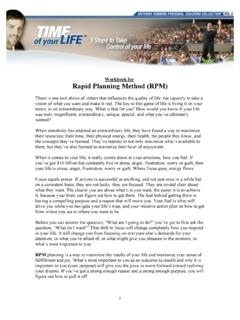Transcription of Hayes White Paper Strategic Planning in Healthcare
1 Rob Drewniak Director, Strategic & Advisory Services Hayes Management Consulting White Paper 7 Steps to Healthcare Strategic Planning Hayes White Paper : Healthcare Strategic Planning 2 In Healthcare today, challenges surface almost daily in terms of finance, reform, government mandates and policy, technology, and customer satisfaction. It is crucial that Healthcare leaders step back and continually assess the organization s Strategic plan. In fact, Strategic thinking, assessing and modeling are becoming requirements for an organization to survive the turbulent Healthcare climate.
2 Strategic Planning provides a roadmap to where the company is going, and directions on how to get there. It is used to guide all decisions, including those regarding capital, technology, staff and other resources. Various business analysis techniques can be used in Strategic Planning , including SWOT analysis (Strengths, Weaknesses, Opportunities, and Threats), PEST analysis (Political, Economic, Social, and Technological), to define direction. Throughout the process, Strategic Planning is the formal consideration of an organization's future course. All Strategic Planning deals with at least one of three key business questions: "What do we do?
3 " "For whom do we do it?" "How do we excel?" Strategic help us see the bigger picture when it is easier to get lost in the day to day operational issues. Big picture issues include: Service or technology portfolios Competitive and regulatory pressures and changes Success factors Functional business models and departmental alignment Goals and objectives Organizational culture Core competencies Current conditions We can then create proactive strategies to move from current state to desired state. Information technology is a large part of this equation.
4 Therefore, it is important to be very familiar with the current state of IT, and what you will need in this area to meet future goals. Historically, organizations have developed Strategic plans for three to five years. However, with Healthcare reform, new technology, and staffing issues in the industry, the Strategic Planning process has become more frequent, and rightly so. 7 Steps to Strategic Planning We at Hayes recommend the following seven step process for Strategic Planning : Step 1 Review/Develop Vision & Mission Although many organizations have created vision, mission, goals and objectives, these elements need to be reviewed on a continuous basis.
5 The reason lies in the ever changing environment and business constraints forced upon organizations through government, payors, competition, physicians, patients, vendors etc. Each internal department s vision and mission must be aligned and supportive of the overall business strategy. Hayes Management White Paper : Strategic Assessments 3 The mission of an organization is the reason it exists. Usually the mission takes the form of a statement, which conveys a sense of purpose to the employees, patients, physicians and the community. The mission sets the tone for goals and objectives.
6 Information Technology Strategic Planning There is a mutually dependent relationship between the organizational Strategic plan and the information technology Strategic plan. It is essential that when creating the overall Strategic plan, a parallel process is performed to create or adjust the IT Strategic plan. They inform each other. For example, if an organization s leaders decide to start an accountable care organization (ACO), they need to understand the ability of the IT group to support it. Figure 1: Organizational and IT Plans Dependency Any organization Planning to develop new delivery models such as home health expansion, accountable care processes, etc.
7 , will require both operational and information technology Strategic changes. Step 2 Business and Operational Analysis One of the key objectives of Strategic Planning is to understand internal strengths and weaknesses as well as external threats and opportunities, a SWOT analysis. It is critical to engage stakeholders from across the organization and vendors as well to provide their points of view. This involvement will not only improve your plan, it will create organizational ownership, which will be important for executing and sustaining the plan. Look at these aspects from an internal and external perspective: Company culture Company image Organizational structure Key staff and overall personnel Access to resources Operational efficiency Operational capacity Market awareness Financial resources Information systems and resources The findings from this exercise greatly inform the Strategic plan.
8 For example, one Hayes client observed changes in the external environment which prompted the decision to Hayes White Paper : Healthcare Strategic Planning 4 move toward an acquisition and merge model. This plan required significant Strategic and tactical changes. Step 3 Develop and Select Strategic Options All possible strategies should be developed based on the inputs. Then the list should be narrowed down to strategies that are within the guiding priniciples of the organization. Guiding principles identify the ground rules and parameters that will inform decision making for your organization.
9 For example, will your organization consider merging with or acquiring another organization to meet its goals? Do you want to outsource certain functions? Another decision making criterion is your organizational capacity. For example, if a goal is to increase revenue in orthopedics by 7%, are there enough physicians to support that increase in volume? Do they specialize in the services that will meet that goal? You should have a few strategies outlined before you go to step 4. Step 4 Establish Strategic Objectives This step narrows the list even more by applying various models (financial, etc.)
10 To each strategy to determine the effect it will have on the organization. This step is also where key measures and timelines are established or validated. Once the strategies are tested in this way, it can be put together to form the Strategic plan. The plan s components should be specific, measurable, achievable, realistic and time bound (SMART). Step 5 Strategy Execution Plan Now a plan must be developed to implement the chosen Strategic options. To be successful, you will need organizational ownership of the plan, which includes not only executive sponsorship, but also the active involvement of all staff members.







